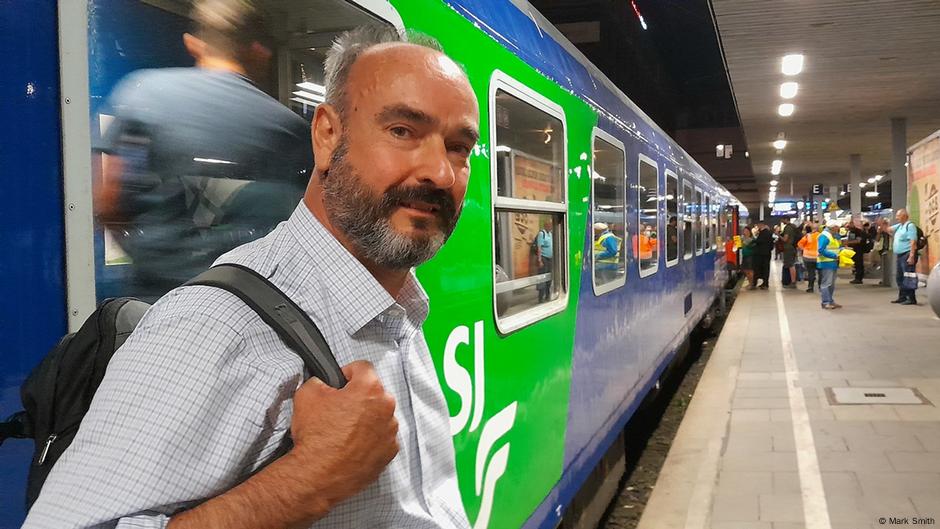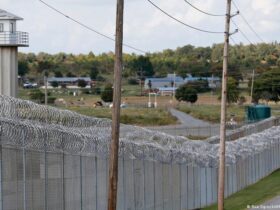It’s a regular morning bustling with activity on platform 12 of Berlin Central Station. As soon as the train arrives, there is a sound of brakes. Passengers move to the tune of a loudspeaker announcement, then a whistle blows, the doors close and the wheels start spinning. Mark Smith is out again.
“When i’m on a tripThere’s a sense of anticipation and possibility,” he says, adding that the possibilities are greater than most people imagine. “If the situation in Russia wasn’t there, you could get to Hong Kong or Singapore by train.”
Although he is not traveling that far, his journey is long enough that most people cannot see the railway as a viable option. He is traveling from his UK home near London to a conference in the Estonian capital, Tallinn.
This journey would add 1,800 kilometers (1,118 mi) to the hundreds of thousands of rail kilometers they had already covered. It would also take four days and eight trains, and the ticket alone would cost about $500. By air, the same trip will take less than three hours and can be as cheap as $25. So, why would anyone choose the slow and expensive option?
A life dedicated to the railways
Berlin was Mark Smith’s first overnight stop, and the train he boarded at Platform 12 would take him to Warsaw, Poland for his next stop. As the trains roll through the urban outskirts and into fields and forests, he sits in the restaurant car and tells how he first fell in love with rail travel. At the young age of 17 years.
He recalls, “What attracted me were school trips to the south of France and Russia by train.” “There were views, there were people, there was a realness to it that air travel didn’t have.”
Later, to earn money during his studies, he worked for a travel agency issuing train tickets. He recalls, “I was doing what I loved. I knew all the connections because I’d had them myself.” He managed stations in London and worked for the UK Department for Transport.
And then one day in 2001, he went to a press store at London’s Marylebone station and bought a magazine about how to set up a website using HTML. He recalls, “Probably the best £2.95 ($3.96) I’ve spent in my life.”
A Wikipedia for rail travel
Smith set up a website called seat61.comNamed after his favorite spot on the Eurostar train that connects London to the continent via the Channel Tunnel. It soon turned from a hobby to a full-time job.
Over the years they have essentially created a Wikipedia for train travel, with information about routes, trains, fares, essential information and little life hacks for train travel in over 100 countries.
He says the website gets up to 1 million visits per month. “When I started in 2001, people told me they were afraid of flying or had medical restrictions. But now they tell me they want a better experience from air travel and want to cut their emissions.”
Rail wins emissions race
Globally, air travel is responsible for about 2.5% of total human-caused CO2 emissions, with private cars accounting for less than 10% and rail for 0.26%.
To fly from London to Tallinn, Estonia, approximately 380 kilograms of carbon dioxide is emitted per passenger on a direct flight. By car, it is even higher depending on fuel and number of passengers.
However, a train journey produces only 110 to 140 kg of CO2. And this will be even less if, in the coming years, the last diesel trains used on the route are replaced by electric trains powered by renewable energy.
stress is a deal breaker
Apart from climate change, there are also disadvantages of traveling long distances by train. “Fragmentation is the biggest problem,” says Smith. For their journey to Tallin, they had to use trains from six different rail companies with individual booking systems, languages and currencies. And this is not unusual. There is no incredulity either.
“People have been treated like cargo for too long,” says Pete Dyson, a behavioral scientist at the University of Bath in Britain. “The priority is just to get people from A to B, as if you are a package that has to be delivered.”
He says the fact that trains can and do stop suddenly midway can cause anxiety that distracts people. And although lines in parts of Europe have been deteriorating for some time, modernization is expensive.
In 2018, building high-speed railways in EU countries cost an average of 25 million euros ($29.22) per kilometer. The same stretch of highway costs at most half that. Electric wiring and signaling on train routes also makes maintenance of the railway network more expensive.
With air travel, physical infrastructure costs are limited to airports. Airlines also benefit from tax exemption on fuel and VAT in many countries.
In some cases, to Mark Smith’s dismay, passengers may have to pay tax on their train ticket, but not on their flight. He says, “It’s not that we need to make air travel less attractive. It’s that we need to stop deliberately making it more attractive than it has to be.”
Despite falling costs, in Europe and globally, train travel is increasing both in terms of kilometers of track and number of passengers. 2024 marked the first time that more than a billion people traveled around the world by long-distance or cross-regional train.
Five hours later, Mark gets off the train in Warsaw and walks around the station taking photos for his website. “We shouldn’t be telling people they can’t fly and have to take the train,” he says.
“Sustainability isn’t a punishment. Train travel takes longer, but hey, it’s a better, more rewarding experience. You’re doing yourself a favor as well as the planet.”
Edited by: Tamsin Walker






Leave a Reply